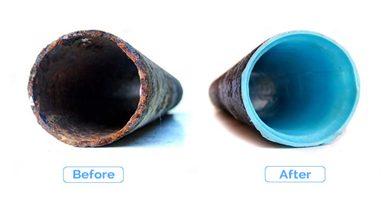
Learn How We Repair Sewer Pipes
The District uses two primary methods to repair gravity pipelines. One method is called open-trench construction and the other is called cured-in-place pipe lining (CIPP). The traditional open trench requires digging a trench for pipe removal and installation. This method is usually expensive, time-consuming, and disrupts traffic. However, open trench may be required due to the type of pipe defect. The trenchless CIPP method is preferred because it is cost-effective, less intrusive, and faster.
CIPP involves inserting a flexible liner inside an existing sewer pipe and curing it to essentially form a new pipe within the pipe. The new liner extends the pipe’s life by 50 years or more.
The first step of the CIPP process involves cleaning the existing sewer pipe by removing any roots, debris, or grease. After the existing sewer pipe is cleaned, a flexible tube-shaped liner is covered with resin. Next, the liner is pushed into the existing sewer pipe and inflated using air pressure. Lastly, to keep the shape of the tube-like liner, the resin is heated using either steam, hot water, or ultraviolet light. The new liner forms a smooth interior surface inside the existing sewer pipe, restoring it to near new condition.
